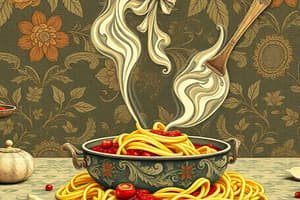Podcast
Questions and Answers
Pasta is made from wheat dough formed into shapes such as spaghetti, macaroni, and lasagna.
Pasta is made from wheat dough formed into shapes such as spaghetti, macaroni, and lasagna.
True
Rice and corn are common ingredients used to make gluten-free pasta.
Rice and corn are common ingredients used to make gluten-free pasta.
True
Orecchiette is an example of Italian pasta that resembles small shells when cooked.
Orecchiette is an example of Italian pasta that resembles small shells when cooked.
True
Pasta should be cooked al dente, which means soft and mushy.
Pasta should be cooked al dente, which means soft and mushy.
Signup and view all the answers
It's recommended to frequently check the pasta while cooking to avoid it becoming soggy and mushy.
It's recommended to frequently check the pasta while cooking to avoid it becoming soggy and mushy.
Signup and view all the answers
Fresh pasta has a longer shelf life compared to dried pasta.
Fresh pasta has a longer shelf life compared to dried pasta.
Signup and view all the answers
Marinara sauce is a cream-based sauce commonly used with pasta dishes.
Marinara sauce is a cream-based sauce commonly used with pasta dishes.
Signup and view all the answers
Dry pasta requires refrigeration before opening to maintain its quality.
Dry pasta requires refrigeration before opening to maintain its quality.
Signup and view all the answers
Fusilli pasta is shaped like petite trumpets.
Fusilli pasta is shaped like petite trumpets.
Signup and view all the answers
Alfredo sauce is a vegetarian sauce made with eggplant or zucchini.
Alfredo sauce is a vegetarian sauce made with eggplant or zucchini.
Signup and view all the answers
Study Notes
Pasta is a versatile food item made from wheat dough that has been formed into different shapes such as spaghetti, macaroni, and lasagna. It's popular worldwide because it's tasty and can be prepared quickly with just boiling water. There are many variations of pasta due to differences in ingredients, shape, serving size, cooking method, and sauce used. Here, we will discuss some key aspects related to pasta preparation and consumption.
Types of Pasta
The most common type of pasta comes from wheat flour mixed with eggs and sometimes semolina flour. There are also gluten-free alternatives like rice or corn pastas available today. Additionally, there are other speciality varieties of pasta, including stuffed pastas and wholemeal options. Each country tends to have its own traditional pasta dishes; Italy being particularly well known for this. One example of Italian pasta is Orecchiette, which translates to “little ears” and resembles small shells when cooked.
Determining Pasta Doneness
Pasta cooks best when al dente — meaning firm yet tender — according to food experts. To check if your pasta is done you should taste test it after around eight minutes of boiling. If it feels soft to the bite it needs more cooking time until it becomes firmer. Overcooked pasta gets soggy and mushy so avoid overdoing it by checking frequently while cooking.
Types of Pasta Sauce
There are numerous types of pasta sauce depending on regional traditions, seasonality, availability of ingredients and personal preference. Some common ones include tomato based marinara sauce; creamier Alfredo sauce; garlic butter parmesan; basil pesto; meat ragus; vegetarian ragus featuring eggplant or zucchini; hearty bean stews with pasta added towards the end; vegetable-based sauces served cold during hot summer months; vegetarian bolognese similar to traditional Bolognese recipe except without wine or meat broth; seafood pasta featuring clams or shrimp; caprese salad featuring mozzarella cheese slices layered between tomatoes with olive oil drizzled on top. A wide variety of herbs, vegetables, meats, fish, cheeses and condiments may come together in any number of combinations creating endless possibilities.
Fresh Vs Dried Pasta
Fresh pasta requires more attention but yields better results, whereas dry pasta lasts longer, though its quality degrades rapidly once opened. Dry pasta does not require refrigeration before opening making them convenient and ready for immediate consumption. However, their shelf life is limited compared to those stored under controlled conditions inside vacuum-packed packages. Cooking fresh pasta takes less time than standard durum wheat based products due to higher moisture levels within each noodle strand. For instance, one might need six minutes instead of ten minutes per batch when working with homemade fettuccine.
Texture Of Pasta
Apart from the basic difference between al dente and fully cooked, there are several textures that influence the final outcome of pasta dishes. These range from smooth, silky ribbonlike forms like angel hair linguini; tougher cut spirals like rigatoni which hold up well against chunky sauces; delicate twirly braids shaped like petite trumpets called fusilli; thick sheets folded upon themselves to create cavatelli-style coils; stubby little tubes filled with ricotta called tortellini; or mounded cupcake sculptured balls dubbed gnocchi - these differ greatly in feel even though they all share the name 'pasta.' Regardless of what kind you prefer, every variety brings something unique to the table, promising new adventures with every dish.
Studying That Suits You
Use AI to generate personalized quizzes and flashcards to suit your learning preferences.
Description
Explore the diverse world of pasta - from different types to determining doneness, types of sauces, fresh vs dried pasta, and various textures. Learn about pasta's versatility and how to best enjoy it in your meals.




